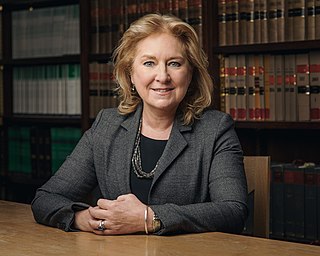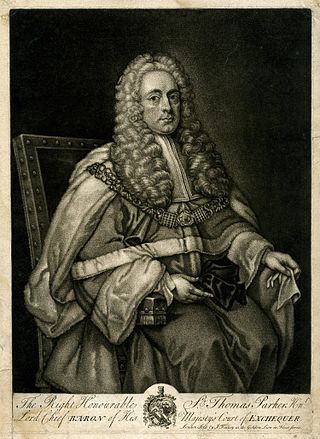Related Research Articles

The Lady Chief Justice of England and Wales is the head of the judiciary of England and Wales and the president of the courts of England and Wales.
The Chancellor of the Exchequer of Ireland was the head of the Exchequer of Ireland and a member of the Dublin Castle administration under the Lord Lieutenant of Ireland in the Kingdom of Ireland. In early times the office was sometimes called the Chancellor of the Green Wax. In the early centuries, the Chancellor was often a highly educated cleric with knowledge of Finance. In later centuries, when sessions of Parliament had become regular, the Chancellor was invariably an MP in the Irish House of Commons. Walter de Kenley, Chancellor from 1292 until his death, was both a judge of the Court of Common Pleas (Ireland) and a distinguished military commander who gave good service against the Gaelic clans of County Wicklow.

The Court of King's Bench was one of the senior courts of common law in Ireland. It was a mirror of the Court of King's Bench in England. The King's Bench was one of the "Four Courts" which sat in the building in Dublin which is still known as "The Four Courts", and is still in use.

The Exchequer of Ireland was a body in the Kingdom of Ireland tasked with collecting royal revenue. Modelled on the English Exchequer, it was created in 1210 after King John of England applied English law and legal structure to his Lordship of Ireland. The Exchequer was divided into two parts; the Superior Exchequer, which acted as a court of equity and revenue in a way similar to the English Exchequer of Pleas, and the Inferior Exchequer, which directly collected revenue from those who owed The Crown money, principally rents for Crown lands. The Exchequer primarily worked in a way similar to the English legal system, holding a similar jurisdiction. Following the Act of Union 1800, which incorporated Ireland into the United Kingdom, the Exchequer was merged with the English Exchequer in 1817 and ceased to function as an independent body, although the Irish Court of Exchequer, like other Irish courts, remained separate from the English equivalent.

Sir Thomas Parker, PC (1695–1784) was an English barrister and judge, Privy Counsellor and Lord Chief Baron of the Exchequer.

Philip Tisdall SL was an Irish lawyer and politician, who held the office of Attorney-General for Ireland. He was for many years a leading figure in the Irish Government.
Sir Richard Levinge, 1st Baronet was an Irish politician and judge, who played a leading part in Irish public life for more than 30 years.

Henry Singleton (1682–1759) was an Irish politician and judge, who is remembered now mainly for his friendship with Jonathan Swift, and for his notable acts of charity during the Great Irish Famine of 1740-1, in which between 300,000 and 500,000 people died. Singleton House, his impressive townhouse in Drogheda, no longer exists.

The chief justice of the Common Pleas for Ireland was the presiding judge of the Court of Common Pleas in Ireland, which was known in its early years as the Court of Common Bench, or simply as "the Bench", or "the Dublin bench". It was one of the senior courts of common law in Ireland, and was a mirror of the Court of Common Pleas in England. The Court of Common Pleas was one of the "four courts" which sat in the building in Dublin which is still known as the Four Courts, apart from a period in the fourteenth century when it relocated to Carlow, which was thought, wrongly as it turned out, to be both more central and more secure for the rulers of Norman Ireland.

The Court of Common Pleas was one of the principal courts of common law in Ireland. It was a mirror image of the equivalent court in England. Common Pleas was one of the four courts of justice which gave the Four Courts in Dublin, which is still in use as a courthouse, its name. Its remit as in England was to hear lawsuits between ordinary citizens.
Sir James Reynolds (1684–1747) was an English judge who had a distinguished career in both Ireland and England, holding the office of Chief Justice of the Irish Common Pleas and subsequently Baron of the Exchequer in England. He should not be confused with his close relative Sir James Reynolds, junior, who was Chief Baron of the Exchequer from 1730 to 1738.

The Court of Exchequer (Ireland), or the Irish Exchequer of Pleas, was one of the senior courts of common law in Ireland. It was the mirror image of the equivalent court in England. The Court of Exchequer was one of the four royal courts of justice which gave their name to the building in Dublin in which they were located, which is still called the Four Courts, and is in use as a courthouse.
Sir James Dowdall was an Irish judge of the Elizabethan era who briefly held office as Lord Chief Justice of Ireland. He should not be confused with James Dowdall, the Catholic martyr, who was his cousin.
Richard Delahide was an Irish judge of the sixteenth century, who held the offices of Chief Justice of the Irish Common Pleas and Chief Baron of the Irish Exchequer. His career was seriously damaged by the Rebellion of Silken Thomas, in which several members of his family played a leading part, and he was fortunate to escape permanent disgrace.
William de Meones was an English-born cleric and judge in fourteenth-century Ireland, who was the second Chief Baron of the Irish Exchequer. Today he is chiefly remembered for giving his name to the Dublin suburb of Rathmines.
John Keppock was an Irish judge of the late fourteenth century, who held the offices of Lord Chief Justice of Ireland, Chief Baron of the Irish Exchequer and Deputy Lord Chancellor of Ireland. He became a politician of some importance.
Henry Mitchell (c.1320–1384) was an Irish judge of the fourteenth century. He was one of the first recorded holders of the office of Attorney General for Ireland, and was subsequently Chief Baron of the Irish Exchequer and Chief Justice of the Irish Common Pleas.
Thomas de Chaddesworth, de Chedworth or de Chadsworth was an English-born Crown servant and cleric who spent some fifty years in Ireland, and died there at a great age.
Richard le Brun was an English-born cleric, judge and Crown official in fourteenth-century Ireland. He was Chief Baron of the Irish Exchequer 1319-1324.
John Blakeney was an Irish judge of the fifteenth century, who served three times as Chief Justice of the Common Pleas.
References
- ↑ As reported by The North-British Intelligencer October 1776
- 1 2 3 4 Ball, F. Elrington The Judges in Ireland 1221-1921 London John Murray 1926 Vol. 2 p.207
- ↑ No trace of Rathmines Castle remains today, but it probably stood at the site of present-day Palmerston Park, Rathmines- see Deirdre Kelly Four Roads to Dublin O'Brien Press (1995).
- ↑ London Chronicle, 31 March 1761.
- ↑ "No. 10090". The London Gazette . 24 March 1761. p. 2.
- ↑ The North-British Intelligencer October 1776
- ↑ "Historical Account of Charter-House" London 1808